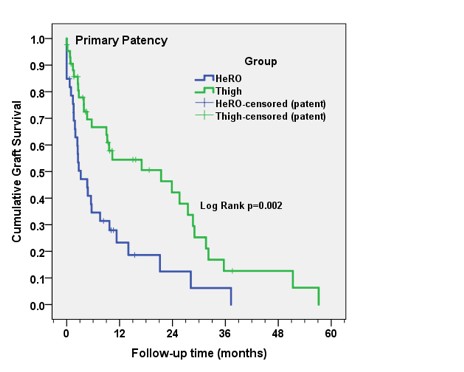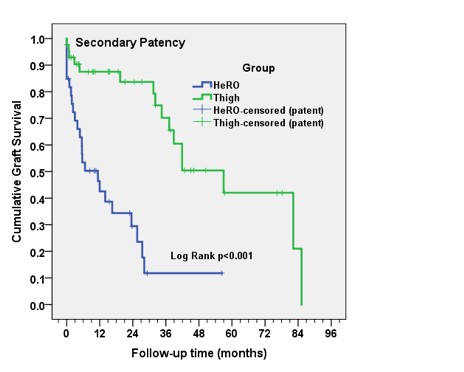Back to 2016 Annual Meeting Program
A Comparison of Patency and Interventions in Thigh versus HeRO Grafts for Chronic Hemodialysis
Evan R Brownie1, Clark D Kensinger1, Derek E Moore2, Irene D Feurer3, David Shaffer4
1Vanderbilt University Medical Center, Department of Surgery, Nashville, TN;2Vanderbilt University Medical Center, Assistant Professor of Surgery, Nashville, TN;3Vanderbilt University Medical Center, Departments of Surgery and Biostatistics, Nashville, TN;4Vanderbilt University Medical Center, Professor of Surgery, Nashville, TN
Background:
With improvements in medical management and survival of patients with end-stage renal disease, maintaining durable vascular access remains a challenging problem. Hemodialysis Reliable Outflow (HeRO) grafts were developed as an alternative to prosthetic lower extremity arteriovenous grafts in patients who have exhausted traditional upper extremity access. The aims of this study were to compare patency duration and evaluate whether the number of interventions to maintain or restore patency differed between prosthetic femoral-femoral looped inguinal access (Thigh) and HeRO grafts.
Methods:
A single-center, retrospective, intention-to-treat analysis of consecutive Thigh and HeRO grafts from May 2004 through June 2015 was conducted. Medical history, patency times, number of interventions to maintain or restore patency, and complications were abstracted from the electronic medical record. Data were analyzed using Fisher’s exact test, Kaplan-Meier survival methods, and multivariable logistic regression.
Results:
Seventy-six (43 Thigh, 33 HeRO) grafts were placed in 61 patients (age 26±13 years, 54% male). Median follow-up time for patency was 21 (range: 0-85) months for Thigh and seven (range: 0-56) months for HeRO grafts. Included were one Thigh (2%) and five HeRO (15%) grafts having initial failure. The groups were comparable for sex, age, coronary artery disease, diabetes mellitus, peripheral vascular disease, and smoking history (all P≥.162). Patients had a median of three attempts at conventional arteriovenous access prior to proceeding with a Thigh or HeRO graft and 34% had attempted peritoneal dialysis. Primary [Figure 1], assisted primary, and secondary [Figure 2] patency was significantly longer in the Thigh grafts (all Log Rank P≤.002). In this intention-to-treat analysis, mean [95%CI] primary patency times were 20.28 [14.18, 26.38] and 8.52 [4.46, 12.58] months, assisted primary patency averaged 38.99 [27.32, 50.66] and 10.51 [6.00, 15.01] months, and secondary patency averaged 53.29 [41.52, 65.05] and 16.05 [9.26, 22.84] months for Thigh and HeRO grafts, respectively. The number of procedures per graft to maintain or restore patency averaged three (range: 0-27) in the Thigh and two (range: 0-9) in the HeRO group. After adjusting for follow-up time (P=.006), there was no difference between the groups in the number of interventions performed to maintain or restore patency (P=.105). There was no difference in ischemic (P=.513) or infectious (P=.779) complications between the groups.
Conclusions:
Thigh grafts have significantly better primary, assisted primary, and secondary patency when compared to HeRO grafts. There is no difference in the number of interventions to maintain or restore patency between the groups after adjusting for follow-up time. While HeRO grafts may extend the use of the upper extremity, Thigh grafts provide a more durable option for chronic hemodialysis in this challenging population. 

Back to 2016 Annual Meeting Program
